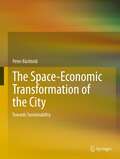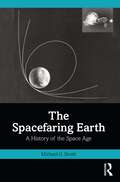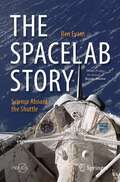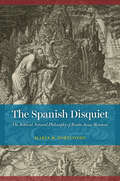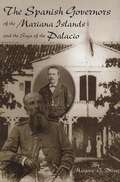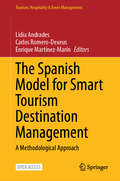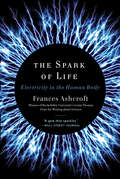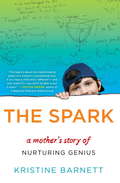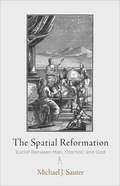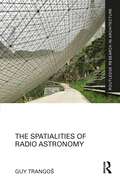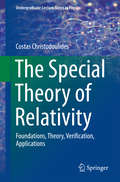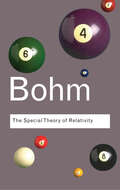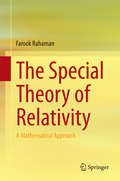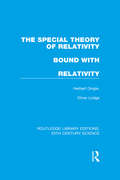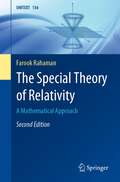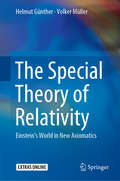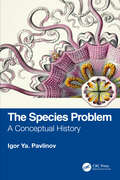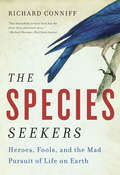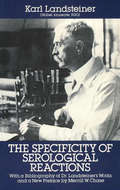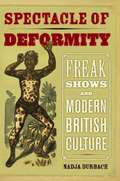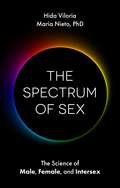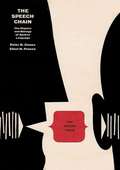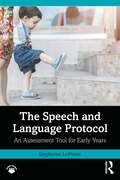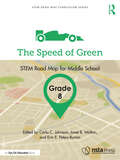- Table View
- List View
The Space-Economic Transformation of the City
by Peter BächtoldCity planning is the key-stone to tackle the question of climate-change and to involve adequate action. In Part I of this book, the theory of space-economy is presented. Opening up a new conceptual and operational toolbox for policy makers, practitioners and scholars, the theory of space-economy is based on a rigorously structured thinking and acting in the field of sustainable urban planning and architecture. Europe has the greatest experience in sustainable city planning worldwide. In Part II, four of the most remarkable experiences (Vauban in Freiburg i.B., Kronsberg in Hannover, Western Harbour in Malmö, Hammarby Sjöstad in Stockholm) are presented, dissected conceptually and operationally a radically new way. The interest of the approach is not limited to European countries. In Part III is developed a project in Asia, in Ho Chi Minh City, faced with dramatic threats due to climate change and rapidly growing tidal and sea-level rise. Based on the experiences presented in Part II, the approach is integrated in this completely different context, thus becoming fully effective at a much bigger scale.
The Spacefaring Earth: A History of the Space Age
by Michael G. SmithThis engaging survey of the Space Age links science and technology with politics and popular culture, war and peace, and crises and controversies. It examines the history of spaceflight as a mirror of human thought and action across the Earth.The volume encompasses the new astronomy and sciences of the modern era, the early dreamers and pioneers after 1903, the national competitions of the First World War, the rocket states that prepared for the Second World War, the rivalries and “space race” of the Cold War between the US and USSR, as well as more recent developments including the Space Shuttle, the International Space Station, national space programs, orbital technologies, transhumanism, and military and commercial ventures in space. It also stresses the importance of geography in the geopolitics of spaceflight competition and in the nature of the planetary biosphere. Taking a chronological approach to lived human experience and threshold achievements, the chapters show how these themes have been reflected in literature, art, music, film, and our new digital worlds.This book is essential reading for students of the history of the Space Age, as well as an excellent companion to courses on twentieth‑century science and technology, the Cold War, and American history.
The Spacelab Story: Science Aboard the Shuttle (Springer Praxis Books)
by Ben EvansBetween 1983 and 1998, Spacelab provided NASA with a vital short-term laboratory in space. Across more than a dozen missions, Spacelab’s pressurized research modules and science pallets supported hundreds of experiments from the life to microgravity sciences, from Earth science to astrophysics and from materials processing to fluid dynamics. For the first time, The Spacelab Story sheds light on all the Spacelab missions that served as pathfinders for the eventual International Space Station, along with all the flights that never came to be. The book chronicles over two decades of service and international partnership with Germany, Japan, Canada, Russia, the member-states of the European Space Agency and others. The very same international co-operation that led to Spacelab’s genesis also conspired to create its end. Science writer Ben Evans chronicles this tumultuous history, showing how, as tensions between the superpowers cooled in the 1990s and the Shuttle cameto be increasingly used to fly joint missions to Mir, many Spacelab missions were delayed and eventually cancelled. This book is a must-read for anybody interested in the science conducted aboard the Shuttle, the experimental precursors of the ISS, and the international politics surrounding NASA’s pioneering space endeavors.
The Spanish Disquiet: The Biblical Natural Philosophy of Benito Arias Montano
by María M. PortuondoIn this book, historian María M. Portuondo takes us to sixteenth-century Spain, where she identifies a community of natural philosophers and biblical scholars. They shared what she calls the “Spanish Disquiet”—a preoccupation with the perceived shortcomings of prevailing natural philosophies and empirical approaches when it came to explaining the natural world. Foremost among them was Benito Arias Montano—Spain’s most prominent biblical scholar and exegete of the sixteenth century. He was also a widely read member of the European intellectual community, and his motivation to reform natural philosophy shows that the Spanish Disquiet was a local manifestation of greater concerns about Aristotelian natural philosophy that were overtaking Europe on the eve of the Scientific Revolution. His approach to the study of nature framed the natural world as unfolding from a series of events described in the Book of Genesis, ultimately resulting in a new metaphysics, cosmology, physics, and even a natural history of the world. By bringing Arias Montano’s intellectual and personal biography into conversation with broader themes that inform histories of science of the era, The Spanish Disquiet ensures an appreciation of the variety and richness of Arias Montano’s thought and his influence on early modern science.
The Spanish Governors Of The Mariana Islands And The Saga Of The Palacio
by Marjorie G. DriverMore than fifty Spanish officers served as governors during the 230 years that Spain administered the Mariana Islands, from 1668 to 1898. A dozen or so received six-year royal appointments, made in Madrid by the king, though the vast majority served three-year interim appointments, made in Manila by the Governor General or the Audiencia. In the nineteenth century, as the newly designated Province of the Mariana Islands, appointments to the governorship were often made by the Captaincy General of the Philippines. The source materials for this work are found primarily among the holdings of the Micronesian Area Research Center, Spanish Documents Collection, a secondary repository with copies of documentary materials concerning Micronesia from institutional collections in various parts of the world, though primarily Spain, Mexico, and the Philippines.
The Spanish Model for Smart Tourism Destination Management: A Methodological Approach (Tourism, Hospitality & Event Management)
by Lidia Andrades Carlos Romero-Dexeus Enrique Martínez-MarínThis is an open access handbook that guides destinations on their journey to becoming Smart Tourism Destinations (STDs). Developed by SEGITTUR, a distinguished Spanish State company, and aligned with academia represented by Professor Lidia Andrades, who has brought together recognized international academics with SEGITTUR experts in the field of tourism management to write this groundbreaking book, it offers practical insights and strategies for success. Explore the characteristics and implications of smart destinations, across the five dimensions which structure them: destination governance, accessibility, technology, innovation and sustainability, navigate the transition from traditional tourism management to the innovative smart managerial paradigm, and overcome challenges encountered during the transformative process. Equipping destination managers with essential tools and strategies, this handbook showcases real-life examples of Spanish destinations embracing the smart tourism paradigm. Drawing on SEGITTUR's proven methodology, it provides precise guidance, checklists, and expert recommendations for effective implementation. An invaluable resource for destination managers, tourism professionals, and researchers, it unlocks the full potential of smart tourism destinations.
The Spark of Life: Electricity in the Human Body
by Frances AshcroftWhat happens during a heart attack? Can someone really die of fright? What is death, anyway? How does electroshock treatment affect the brain? What is consciousness? The answers to these questions lie in the electrical signals constantly traveling through our bodies, driving our thoughts, our movements, and even the beating of our hearts. The history of how scientists discovered the role of electricity in the human body is a colorful one, filled with extraordinary personalities, fierce debates, and brilliant experiments. Moreover, present-day research on electricity and ion channels has created one of the most exciting fields in science, shedding light on conditions ranging from diabetes and allergies to cystic fibrosis, migraines, and male infertility. With inimitable wit and a clear, fresh voice, award-winning researcher Frances Ashcroft weaves together compelling real-life stories with the latest scientific findings, giving us a spectacular account of the body electric.
The Spark of Life: Electricity in the Human Body
by Frances Ashcroft"A gem that sparkles."--William Bynum, Wall Street Journal What happens during a heart attack? Can someone really die of fright? What is death, anyway? How does electroshock treatment affect the brain? What is consciousness? The answers to these questions lie in the electrical signals constantly traveling through our bodies, driving our thoughts, our movements, and even the beating of our hearts. The history of how scientists discovered the role of electricity in the human body is a colorful one, filled with extraordinary personalities, fierce debates, and brilliant experiments. Moreover, present-day research on electricity and ion channels has created one of the most exciting fields in science, shedding light on conditions ranging from diabetes and allergies to cystic fibrosis, migraines, and male infertility. With inimitable wit and a clear, fresh voice, award-winning researcher Frances Ashcroft weaves together compelling real-life stories with the latest scientific findings, giving us a spectacular account of the body electric.
The Spark: A Mother's Story of Nurturing, Genius, and Autism
by Kristine BarnettThe extraordinary memoir of a mother's love, commitment and nurturing, which allowed her son, originally diagnosed with severe autism, to flourish into a universally recognized genius--and how any parent can help their child find their spark. Today, at 13, Jacob is a paid researcher in quantum physics, working on extending Einstein's theory of relativity. Diagnosed at 1 with severe autism, at 3 he was assigned to life-skills classes and his parents were told to adjust their expectations. The goal: tying his own shoes at 16. Kristine's belief in the power of hope and the dazzling possibilities that can occur when we keep our minds open and learn to fuel a child's true potential changed everything.From the Hardcover edition.
The Spatial Reformation: Euclid Between Man, Cosmos, and God (Intellectual History of the Modern Age)
by Michael J. SauterIn The Spatial Reformation, Michael J. Sauter offers a sweeping history of the way Europeans conceived of three-dimensional space, including the relationship between Earth and the heavens, between 1350 and 1850. He argues that this "spatial reformation" provoked a reorganization of knowledge in the West that was arguably as important as the religious Reformation. Notably, it had its own sacred text, which proved as central and was as ubiquitously embraced: Euclid's Elements. Aside from the Bible, no other work was so frequently reproduced in the early modern era. According to Sauter, its penetration and suffusion throughout European thought and experience call for a deliberate reconsideration not only of what constitutes the intellectual foundation of the early modern era but also of its temporal range.The Spatial Reformation contends that space is a human construct: that is, it is a concept that arises from the human imagination and gets expressed physically in texts and material objects. Sauter begins his examination by demonstrating how Euclidean geometry, when it was applied fully to the cosmos, estranged God from man, enabling the breakthrough to heliocentrism and, by extension, the discovery of the New World. Subsequent chapters provide detailed analyses of the construction of celestial and terrestrial globes, Albrecht Dürer's engraving Melencolia, the secularization of the natural history of the earth and man, and Hobbes's rejection of Euclid's sense of space and its effect on his political theory. Sauter's exploration culminates in the formation of a new anthropology in the eighteenth century that situated humanity in reference to spaces and places that human eyes had not actually seen. The Spatial Reformation illustrates how these disparate advancements can be viewed as resulting expressly from early modernity's embrace of Euclidean geometry.
The Spatialities of Radio Astronomy (Routledge Research in Architecture)
by Guy TrangošThe Spatialities of Radio Astronomy examines the multidisciplinary overlap between the spatial disciplines and the studies of science and technology through a comparative study of four of the world’s most important radio telescopes. Employing detailed analysis, historical research, interviews, personal observations, and various conceptual manoeuvres, Guy Trangoš reveals the depth of spatial process active at these scientific sites and the territories they traverse. Through the conceptual frameworks of territory, hyper-concentration, and contingency, Trangoš interprets the telescope as exploded across space and time, present in multiple connected sites simultaneously, and active in the production of space. He develops a historiographic and contemporary analysis of the Atacama Large Millimeter/submillimeter Array (ALMA, Chile); the Five-hundred-meter Aperture Spherical radio Telescope (FAST, China); the Arecibo Observatory (Puerto Rico); and the MeerKAT/SKA (South Africa). These case studies are global exemplars of the different spatial transformations that occur through science. Their relationships to surrounding communities and landscapes reveal deeper constitutional processes embodied in each institutional and spatial form. This book spans the modern history of architecture and science, the studies of science, technology and society, and urban theory. It is of specific interest to architects and designers expanding their analysis of spatial production, scholars in the study of geography, landscape, science, technology, and astronomy, and people fascinated with how these radio telescopes were conceptualised, built, and operate today.
The Special Theory of Relativity
by Costas ChristodoulidesThis book offers a comprehensive, university-level introduction to Einstein's Special Theory of Relativity. In addition to the purely theoretical aspect, emphasis is also given to its historical development as well as to the experiments that preceded the theory and those performed in order to test its validity. The main body of the book consists of chapters on Relativistic Kinematics and Dynamics and their applications, Optics and Electromagnetism. These could be covered in a one-semester course. A more advanced course might include the subjects examined in the other chapters of the book and its appendices. As a textbook, it has some unique characteristics: It provides detailed proofs of the theorems, offers abundant figures and discusses numerous examples. It also includes a number of problems for readers to solve, the complete solutions of which are given at the end of the book. It is primarily intended for use by university students of physics, mathematics and engineering. However, as the mathematics needed is of an upper-intermediate level, the book will also appeal to a more general readership.
The Special Theory of Relativity
by David BohmIn these inspiring lectures David Bohm explores Albert Einstein’s celebrated Theory of Relativity that transformed forever the way we think about time and space. Yet for Bohm the implications of the theory were far more revolutionary both in scope and impact even than this. Stepping back from dense theoretical and scientific detail in this eye-opening work, Bohm describes how the notion of relativity strikes at the heart of our very conception of the universe, regardless of whether we are physicists or philosophers.
The Special Theory of Relativity
by Farook RahamanThe book expounds the major topics in the special theory of relativity. It provides a detailed examination of the mathematical foundation of the special theory of relativity, relativistic mass, relativistic mechanics and relativistic electrodynamics. As well as covariant formulation of relativistic mechanics and electrodynamics, the book discusses the relativistic effect on photons. Using a mathematical approach, the text offers graduate students a clear, concise view of the special theory of relativity. Organized into 14 chapters and two appendices, the content is presented in a logical order, and every topic has been dealt with in a simple and lucid manner. To aid understanding of the subject, the book provides numerous relevant worked examples in every chapter. The book's mathematical approach helps students in their independent study and motivates them to research the topic further.
The Special Theory of Relativity bound with Relativity: A Very Elementary Exposition (Routledge Library Editions: 20th Century Science)
by Herbert Dingle Sir Oliver LodgeThe Special Theory of Relativity: Based on a short course of lectures delivered in the late 1930s, this short book presents the theory of Special Relativity by formulating a redefinition of the measurement of length, and thus will appeal to students of physics who wish to think through Einstein’s thought without the encumbrance of quasi-scientific concepts and language. Relativity: A Very Elementary Exposition: This brief lecture, delivered in October 1921 and published for the first time in 1925, offers an explanation of Einstein’s theory of Special Relativity for the non-scientist, giving a general overview that does justice both to the actual physics involved, and the wider implications of this revolutionary discovery of the 20th century.
The Special Theory of Relativity: A Mathematical Approach (UNITEXT #136)
by Farook RahamanThis textbook expounds the major topics in the special theory of relativity. It provides a detailed examination of the mathematical foundation of the special theory of relativity, relativistic mass, relativistic mechanics, and relativistic electrodynamics. As well as covariant formulation of relativistic mechanics and electrodynamics, the text discusses the relativistic effect on photons. A new chapter on electromagnetic waves as well as several new problems and examples have been included in the second edition of the book. Using the mathematical approach, the text offers graduate students a clear, concise view of the special theory of relativity. Organized into 15 chapters and two appendices, the content is presented in a logical order, and every topic has been dealt with in a simple and lucid manner. To aid understanding of the subject, the text provides numerous relevant worked-out examples in every chapter. The mathematical approach of the text helps students in their independent study and motivates them to research the topic further.
The Special Theory of Relativity: Einstein’s World in New Axiomatics
by Helmut Günther Volker MüllerThis book discusses in detail the special theory of relativity without including all the instruments of theoretical physics, enabling readers who are not budding theoretical physicists to develop competence in the field. An arbitrary but fixed inertial system is chosen, where the known velocity of light is measured. With respect to this system a moving clock loses time and a moving length contracts. The book then presents a definition of simultaneity for the other inertial frames without using the velocity of light. To do so it employs the known reciprocity principle, which in this context serves to provide a definition of simultaneity in the other inertial frames. As a consequence, the Lorentz transformation is deduced and the universal constancy of light is established. With the help of a lattice model of the special theory of relativity the book provides a deeper understanding of the relativistic effects. Further, it discusses the key STR experiments and formulates and solves 54 problems in detail.
The Species Problem: A Conceptual History
by Igor Ya. PavlinovThe general notion of species is one of the most fundamental in biology. But an idea of species is also one of the most persistent unresolved obsessions of biologists, philosophers and theoreticians. This new book investigates the multifaceted problem species as a "conceptual envelope" of that notion. Contemporary conceptualists and evolutionary epistemology allow for a fresh look by analyzing the framework of history viewed as changes ordered by changing philosophical-scientific contexts. In this analysis, the species problem is characterized in a pluralistic non-trivial manner, in contrast to a more monistic "accepted view." Key Features Provides new insights into the persistent species "problem." Focuses on conceptual history and identifies pivotal landmarks in the history of the concept of species. Argues for a scientific consistency of species pluralism. Discusses the "evolving species-hood" in the context of new essentialism. Related Titles• Wilkins, J. S, et al., eds. Species Problems and Beyond: Contemporary Issues in Philosophy and Practice (ISBN 978-1-0322-2147-2)• Mishler, B. D. What, if anything, are species? (ISBN 978-1-4987-1454-9)• Wilkins, J. S. Species: The Evolution of the Idea, Second Edition (ISBN 978-1-1380-5574-2)• Sigwart, J. D. What Species Mean: A User's Guide to the Units of Biodiversity (ISBN 978-1-4987-9937-9)
The Species Seekers: Heroes, Fools, and the Mad Pursuit of Life on Earth
by Richard ConniffThe story of bold adventurers who risked death to discover strange life forms in the farthest corners of planet Earth. Beginning with Linnaeus, a colorful band of explorers made it their mission to travel to the most perilous corners of the planet and bring back astonishing new life forms. They attracted followers ranging from Thomas Jefferson, who laid out mastodon bones on the White House floor, to twentieth-century doctors who used their knowledge of new species to conquer epidemic diseases. Acclaimed science writer Richard Conniff brings these daredevil "species seekers" to vivid life. Alongside their globe-spanning tales of adventure, he recounts some of the most dramatic shifts in the history of human thought. At the start, everyone accepted that the Earth had been created for our benefit. We weren't sure where vegetable ended and animal began, we couldn't classify species, and we didn't understand the causes of disease. But all that changed as the species seekers introduced us to the pantheon of life on Earth--and our place within it.
The Specificity of Serological Reactions
by Karl LandsteinerSince the discovery that each particular antibody in the blood tends to react primarily with one specific antigen among the hundreds that can be introduced into the system, great strides have been made toward the elimination of disease through immunization. The late Dr. Karl Landsteiner, winner of the Nobel Price in 1930 for the discovery of human blood groups, devoted his life to fundamental research and played a guiding role in the development of several important branches of immunology. This authoritative study is an account of the experiments he and his colleagues carried out on antigens and serological reactions with simple compounds. Beginning with a general discussion of the phenomena of serological specificity, with the emphasis chiefly on the chemical aspects of those reactions that involve immunization, Dr. Landsteiner goes on to cover the topics of natural antigens and antibodies, artificial conjugated antigens, and the reactivity of simple chemical compounds, the chemistry of specific non-protein cell substances, and the developments in our knowledge of serological reactions from a physico-chemical approach. Included in the discussion are his original and fundamental studies in hypersensitivity to chemical allergens and his work with "haptens," on which modern immunochemistry has leaned very heavily. The final chapter, written by Dr. Linus Pauling, carefully presents the principles of molecular structure and intermolecular forces. An extremely valuable feature of this book is the massive bibliography compiled by the author -- over 2,100 items are listed at the chapter ends. A further aid to study and research is the definitive bibliography of Dr. Landsteiner's own writings, new to this edition, and reprinted through the courtesy of the Journal of Immunology. The beginner and advanced student alike will find nowhere else the breadth of coverage given here to basic concepts of immunology. Comprehensive enough for the use of the worker in the field, the book also provides, primarily in an introductory section, explanations and definitions of elementary terminology, concepts, and phenomena of serology for those unacquainted with the subject.
The Spectacle of Deformity: Freak Shows and Modern British Culture
by Nadja DurbachThis vividly detailed work argues that far from being purely exploitative, displays of anomalous bodies served a deeper social purpose as they generated popular and scientific debates over the meanings attached to bodily difference.
The Spectrum of Sex: The Science of Male, Female, and Intersex
by Hida Viloria Maria NietoThis transformative guide completely breaks down our current understanding of biological sex and gender diversity.Introducing readers to seven variations of human sex, commonly considered intersex, the book challenges the myth that sex and gender are binary and explores the inherent diversity of biological sex and its relationship to gender identity and expression, and the impact this has on society. Examining historical, linguistic and socio-cultural understandings of sex and gender, as well as genetic and scientific definitions, the book is an important resource for dismantling gender and sexuality-based discrimination and promoting understanding and inclusivity.Co-written by one of the world's leading intersex activists and a highly respected scholar in biological sciences, and accompanied with detailed anatomical illustrations throughout, this pioneering text is the essential introduction to gender and sex diversity for gender studies, women's studies, biology and genetics courses, as well as professionals working with intersex and trans communities.
The Speech Chain: The Physics And Biology Of Spoken Language
by Dr Elliot N. Pinson Dr Peter B. DenesOriginally published in 1963, The Speech Chain has been regarded as the classic, easy-to-read introduction to the fundamentals and complexities of speech communication. It provides a foundation for understanding the essential aspects of linguistics, acoustics and anatomy, and explores research and development into digital processing of speech and the use of computers for the generation of artificial speech and speech recognition. This interdisciplinary account will prove invaluable to students with little or no previous exposure to the study of language.
The Speech and Language Protocol: An Assessment Tool for Early Years
by Stephanie LoPrestiThis valuable book addresses the common problems faced by speech‑language pathologists, offering solutions and strategies for more effective service delivery.Stephanie LoPresti introduces ‘The Protocol,’ a child development‑based approach that merges principles from developmental psychology and speech‑language pathology. The book covers a wide range of speech and language issues, including receptive, expressive, pragmatic, feeding, and play development, making it a versatile resource for clinicians. It is designed to be easy to use, with movable elements that adapt to a child’s progress from short‑ to long‑term milestones and goals. It emphasizes the concept of the zone of proximal development, ensuring that clinicians work with clients just above their current level of functioning, leading to meaningful progress.Accompanied by downloadable worksheets to assess progress, it will be an essential resource for all speech and language pathologists, particularly those working with young children. It will also be useful to students and educators in the field of speech‑language pathology seeking evidence‑based strategies for working with clients, as well as healthcare professionals, researchers, and educators interested in child development and language acquisition.
The Speed of Green, Grade 8: STEM Road Map for Middle School (STEM Road Map Curriculum Series)
by Carla C. Johnson Erin E. Peters-Burton Janet B. WaltonWhat if you could challenge your eighth graders to design a racing vehicle with minimum environmental impact, while exploring the role of renewable and non-renewable energy sources? With this volume in the STEM Road Map Curriculum Series, you can! The Speed of Green outlines a journey that will steer your students toward authentic problem solving while grounding them in integrated STEM disciplines. Like the other volumes in the series, this book is designed to meet the growing need to infuse real-world learning into K–12 classrooms. This interdisciplinary, eight-lesson module uses project- and problem-based learning to help students explore the potential role of renewable and non-renewable energy sources in transportation, with an emphasis on the auto industry. Using their understanding of the engineering design process (EDP), scientific concepts, and environmental conservation considerations, student teams will develop a plan for a competitive automobile racing team to fuel its vehicle with minimal environmental impact. To support this goal, students will do the following: · Identify finite energy resources and distinguish between these and renewable energy sources, and identify implications of the use of those fuel sources on the environment; · Conduct life cycle analyses (LCAs) of various fuel sources and apply the results to make decisions about the effects of various fuel sources; · Identify several ways that carbon-based fuels have impacted the U.S. economy and foreign relations; · Identify the effects of human activities on the biosphere with an emphasis on the effects of the widespread use of carbon-based fuels; · Apply the engineering design process (EDP) to solve a problem, and design and build a small-scale electric vehicle; · Synthesize their learning and working collaboratively by creating and presenting a plan for a race team that minimizes its environmental impact; · Create an engaging presentation incorporating oral presentations and visual displays to present projects to an audience of peers, teachers, and industry professionals. The STEM Road Map Curriculum Series is anchored in the Next Generation Science Standards, the Common Core State Standards, and the Framework for 21st Century Learning. In-depth and flexible, The Speed of Green can be used as a whole unit or in part to meet the needs of districts, schools, and teachers who are charting a course toward an integrated STEM approach.
